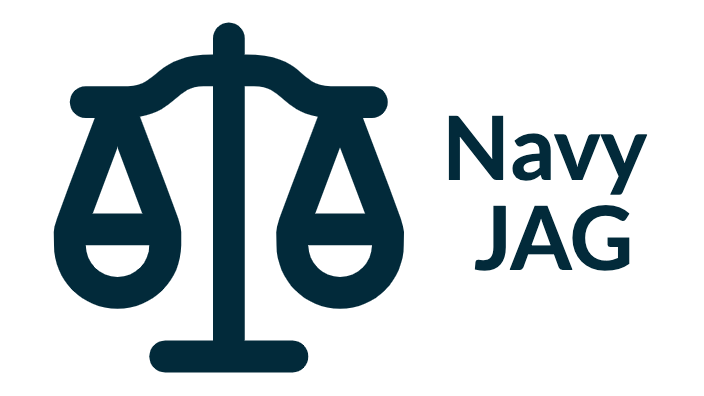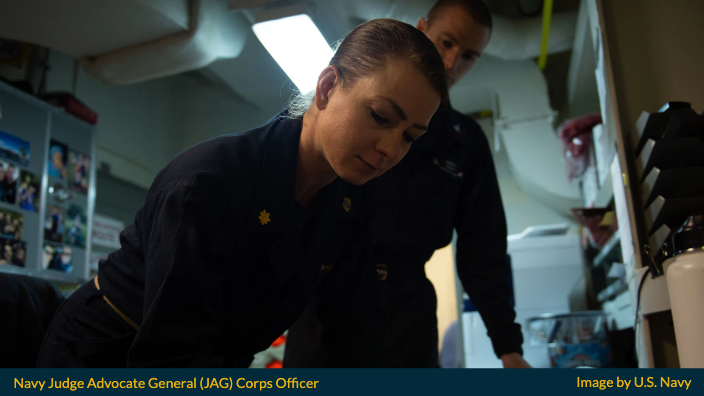Last Updated on March 4, 2024
This guide provides useful information that will help with your decision to become a Navy Judge Advocate General (JAG) Officer during Fiscal Year 2024.
Navy JAG Officers are Staff Corps Officers in the Navy located all over the globe, both on land and at sea, who practice law, assist the Navy, and serve the country. The Navy Officer designator code for Navy JAG is 2500.
As you will see, there are many aspects to the Navy JAG program.
We shall start with the basics.
Navy JAG Corps Officer Job Description

The Navy JAG Corps is made up of approximately 900 uniformed lawyers who are commissioned naval officers in pay grades ranging from Lieutenant Junior Grade (LTJG) to Vice Admiral (VADM).
Being a Navy judge advocate entails embodying the warfighting mentality.
Judge advocates recognize the Navy’s purpose and our role in attaining its goals. We are honored to serve as Navy Sailors and attorneys.
They provide assistance to the fleet and enable the Navy’s mission all over the globe, both on land and at sea.
JAG Officers are required to lead with character and integrity as a Naval Officer.
Their counsel and advocacy highlight basic justice and respect for the rule of law, and it promotes trust in our community, throughout the Fleet, and with the American people.
Being a Navy Officer instills intangible traits that endure a lifetime, such as pride, teamwork, integrity, and a sense of purpose.
Navy judge advocates also recognize that these characteristics make them better leaders and attorneys today and in the future.
They also endeavor to constantly study, analyze, and exchange information in order to broaden our experience and deliver the best legal services possible.
In today’s complicated and dynamic operating environment, Navy JAGs must be nimble — quickly exploiting ideas that produce long-term gains throughout the service.
The Navy JAG Corps is a legal and military vocation. By commissioning as a judge advocate, you will have the opportunity to put your legal abilities to the test, defend the Constitution, and serve our country.
Law Practice in the Navy
As a Navy judge advocate, you will have the most broad legal practice accessible to an attorney and will work in places all over the globe.
Some key areas of Navy JAG work are as follows:
- Legal Counseling (Personal legal services and advice to military members)
- Military Judiciary (Prosecution, defense, judiciary, and appellate)
- Litigation in Civil Court (Cases incident to the operation of the Navy, in conjunction with the Department of Justice)
- Administration of Justice (Government ethics, regulations, and legislation)
- Maritime and Admiralty Law (Admiralty tort and salvage claims, and international and domestic maritime issues)
- International Regulations (international agreements and foreign criminal jurisdiction)
- Environmental Regulations (Laws protecting human health, the environment, and historic and cultural resources)
- National Security Act (Rules of engagement, law of the sea, law of armed conflict, cyber and intelligence law)
Essential Capabilities
The Navy JAG Corps offers legal solutions with an emphasis on three critical capabilities:
Command Advice and Support
The Navy works in a legal and regulatory environment that is becoming more complicated.
Judge advocates offer the legal skills required to execute military operations across the globe.
They also help the Navy as a whole by providing legal counsel for initiatives like recruitment, training, and organization.
Military Justice
The American people expect their military troops to uphold the highest personal and professional standards.
JAG Officers keep the system fair and just by policing military personnel’s behavior and responsibility.
Support to Navy Sailors and their Families
The men and women of the United States Navy are its most valuable asset.
The Navy JAG Corps provides legal aid to military members and their families.
In addition, judge advocates help Wounded Warriors with legal representation and active duty troops with all phases of the disability review procedure.
JAG Corps Officer Salary
Active duty Navy Judge Advocate General compensation ranges from $55,000 to $75,000 per year as a lieutenant junior grade (O2) and $65,000 to $95,000 as a lieutenant (O3), depending on when the officer takes a commission and where they are stationed.
This figure covers basic income as well as various nontaxable perks such as housing and sustenance.
Housing allowances are calculated based on the cost of living in the given location. Pay raises are earned via promotion and longevity.
JAG Corps Officer Promotions
Applicants who are accepted into the Navy JAG Corps Student Program are commissioned as inactive reserve Ensigns (ENS) while attending law school.
While at law school, inactive reserve officers do not earn salary or allowances.
Officers acquire a superseding appointment as a LTJG in the Navy after passing the bar exam and reporting for prolonged active service, beginning at Naval Justice School (NJS).
Before completing Officer Development School, successful candidates to the Navy JAG Corps Direct Appointment Program are commissioned as active duty LTJG.
One year following their first day at the Naval Justice School, officers in the Navy JAG Corps may expect to be promoted to lieutenant (LT).
Student Program and Direct Appointment candidates get up to three years of service credit (for promotion reasons only) for the time they attended law school while not commissioned (additional credit is offered if the student had previous commissioned service).
Service credit accelerates a person’s advancement and determines rank.
This indicates that after no more than 12 months of active service as an LTJG, one may expect to be promoted to LT.
The awarding of service credit has no effect on an individual’s pay rate.
The pay entry base date (PEBD) set upon the officer’s first acceptance of a commission is used to calculate basic pay longevity.
As a consequence, if you are commissioned early, you will get a higher total salary when you begin active service.
Officers in the Navy JAG Corps now spend six to eight years as lieutenants before becoming eligible for promotion to lieutenant commander (LCDR).
LCDRs serve for typically four and a half years before being eligible for promotion to commander (CDR). Annual congressional and Navy officer strength planning choices govern time-in-grade requirements.
The advancement trends of Navy JAG Corps officers are mostly similar to those of their seagoing colleagues.
The promotion schedule below represents averages and may vary by up to 20% due to changes in retention rates and other reasons.
Promotion Timeline
| Paygrade | Average Years in Paygrade |
| O-2: Lieutenant Junior Grade (LTJG) | 1 year in grade |
| O-3: Lieutenant (LT) | 7 years in grade |
| O-4: Lieutenant Commander (LCDR) | 5 years in grade |
| O-5: Commander (CDR) | 6 years in grade |
| O-6: Captain (CAPT) or above | Based on retirement |
Becoming a Navy JAG Officer
The Navy JAG Corps has a number of programs aimed at attracting the finest and brightest attorneys.

To become a Navy JAG Officer, you must be an American citizen, no older than 42 years of age, who is either a current law school student or an experienced licensed attorney.
These programs are described in detail below.
Student Program
The Navy JAG Corps Student Program (SP) allows law students to enlist in the inactive Naval Reserve while still attending law school.
SP members participate on active service for four years, commencing as a LTJG, after graduating from law school, passing a bar exam, and completing Officer Development School.
This is our most important recruitment initiative and the most typical method to join the Navy JAG Corps.
Direct Appointment Program
The Navy JAG Corps Direct Appointment (DA) Program allows licensed lawyers to be appointed to the Navy JAG Corps immediately.
On their first day of active service in the Basic Lawyer Course, DA members are elevated to LTJG.
Participants in the DA are required to spend at least four years on active duty.
The DA program, which has a smaller recruitment pipeline than the SP, is intended to replenish the JAG Corps with seasoned and qualified legal professionals.
Law Education Program
The Navy JAG Law Education Program (LEP) is intended for current active duty Naval Officers who want to go to law school, get a J.D., and subsequently work as judge advocates.
While attending law school and passing the bar exam, selected officers will continue on active service with salary and benefits.
Applicants must be on active duty as commissioned officers, have a college diploma, and be in pay grades 01, 02, or 03, with 2 to 6 years of active service (including any active enlisted time) at the time of application.
Applicants must also be able to complete 20 years of active duty as a commissioned officer before reaching the age of 62, as well as having taken the Law School Admission Test (LSAT) and applied to an ABA-accredited law school.
The LSAT is the primary objective requirement upon which all applicants are compared against. Therefore, it is crucial for applicants to obtain the highest score possible.
Successful Navy JAG applicants in our community recommend only this LSAT Study Guide.
In-Service Procurement Program
The Navy JAG Corps In-service Procurement Program (IPP) offers active duty enlisted Sailors a route to commission as a JAG Corps officer.
Applicants have the option of applying as a Direct Commission Applicant or a Funded Legal Education Training Applicant.
Selectees for IPP Funded Legal Education Training will stay on active service with salary and benefits while attending law school and passing the bar exam.
Reserve Lateral Transfer Program
There is currently no program that permits law students or licensed lawyers without at least one year of cumulative active duty service to join the Navy JAG Corps as a reserve officer.
Career-motivated reservists with the necessary education and professional experience, on the other hand, may pursue a direct commission or a lateral transfer into the Reserve JAG Corps.
The availability of these programs is contingent on the Reserve JAG Corps’ requirements and needs.
Commissioning as a Navy JAG Officer
Applying for the Navy JAG Corps puts you under no obligation.
If you are professionally recommended for a commission after you apply and have satisfied all Navy commissioning process criteria, your Navy recruiter will offer you a commission on behalf of the President of the United States.
Only after you accept the commission, that is, after you have taken the oath of office for a commission and signed a Service Agreement, will you become bound.
A freshly commissioned officer must serve on active service for at least four years.
This time period begins when you report to your first duty post after completing Officer Development School and the Basic Lawyer Course successfully.
After serving four years on active service, you must spend a further four years in the inactive reserve, active reserve, or active duty.
You are not serving in the military while in inactive status, but you are susceptible to recall to active service throughout the four years if a significant war demands such a recall.
There is now no obligation for yearly drills, nor is there any requirement to participate actively in the Reserve Program after inactive status.
If you wish to keep your military connection while pursuing a civilian profession, you may drill in the active Navy Reserve one weekend a month and two weeks a year.
Navy JAG Officer Initial Training
After commissioning, the newly appointed JAG Officers attend the following training:
Officer Development School
Applicants who have never served in the Navy as a commissioned officer will attend Officer Development School (ODS).
The ODS training lasts five weeks and is conducted at Naval Station Newport in Newport, Rhode Island.
ODS offers the required training to equip you to perform as a freshly commissioned Naval Officer.
It offers a basic introduction to essential concepts of leadership, as well as a working understanding of relevant resources.
Naval Justice School
You will be scheduled to attend the Basic Lawyer Course (BLC) at Naval Justice School (NJS) aboard Naval Station Newport after finishing ODS and getting your bar results.
The BLC is available three times a year, with sessions starting in August, October, and January.
The ten-week BLC teaches Navy, Marine Corps, and Coast Guard attorneys the principles of military justice and pertinent civil law, with a special emphasis on trial advocacy skills, administrative law and investigations, legal aid, and basic national security law.
After completing the BLC, you will be assigned to your first permanent duty location.
Navy JAG Officer Duty Stations
These are the typical duty stations for newly commissioned Navy JAG Officers. Individual career experience may vary.
First Duty Station
Your first tour of service will be as a First Tour Judge Advocate (FTJA).
As an FTJA, you will cycle among the three primary Navy JAG Corps practice locations.
An FTJA will spend their first year as a judge advocate, divided evenly between Command Services and Legal Assistance.
The next 12 months will be spent honing litigation abilities in a military justice cycle as either a defense or trial attorney.
The FTJA curriculum is designed to reinforce fundamental competencies via supervised practice, independent study, cooperative learning, observation, and skill display.
Subsequent Duty Stations
Officers may pursue a variety of career opportunities in a variety of practice areas, or they can pursue a professional specialty such as military justice litigation, environmental law, or national security law.
JAG Officers may work on Fleet staff, assist Navy SEAL operations, or deploy abroad or at sea.
Navy JAG Corps Officers serve as legal counsel wherever they are stationed.
You might end yourself in a conflict zone or aboard a combatant ship.
Despite the fact that your main responsibilities will be legal in nature, Navy JAG Corps Officers engage in the ship’s damage control organization and have the chance to assist in ship control activities with all members of the ship’s crew.
Senior Navy judge advocates have an active role in mission planning and implementation.
Sea Duty
Navy judge advocates have the chance to serve at sea with the Navy’s operational units.
Positions on aircraft carriers, submarine tenders, amphibious ships, and with afloat staff deployed on Navy vessels as part of a carrier strike group are available to men and women interested in sea duty.
Sea duty allows you to work directly with the Navy’s operational units while also providing the thrill and challenge of international deployments.
Deployments typically span six to ten months and involve port stops in Europe and Asia.
Deployments also provide a once-in-a-lifetime opportunity to sail renowned waterways such as the Malacca Strait, the Indian Ocean, the Persian Gulf, the Atlantic Ocean, and across the Mediterranean Sea to the Suez Canal and the Red Sea.
Combat Areas
Navy JAG Corps Officers continue to assist land-based foreign contingency operations across the globe.
Navy judge advocates generally serve in these crucial posts for six months to a year.
These foreign contingency operations postings are now purely optional, as many Navy judge advocates continue to volunteer for these historic and hard posts.
Tour Assignments
Navy judge advocates often serve for two to three years in each assignment.
Judge advocates check a list of available posts and geographic locations each assignment cycle and submit their choices to Navy JAG detailers.
While no assurances may be made, detailers make every attempt to assign judge advocates based on their preferences.
Assignments are ultimately driven by the Navy’s shifting requirements, although judge advocates have the chance to discuss prospective assignments with the detailer before orders are issued.
Assignment Locations
Navy Judge Advocates work in a variety of fascinating and varied missions all throughout the globe.
The majority of new Navy judge advocates are stationed in the continental United States.
You may find yourself stationed in one of these major fleet concentration areas:
- San Diego, California
- Norfolk, Virginia
- Bremerton, Washington
- Jacksonville, Florida
- Pensacola, Florida
- Mayport, Florida
- Groton, Connecticut
- Washington, DC
- Pearl Harbor, Hawaii
International duty stations are also available, such as the following:
- Rota, Spain
- Naples, Sigonella, Sicily and Rome, Italy
- Souda Bay, Greece
- Stuttgart and Garmisch, Germany
- Diego Garcia; Guam
- Yokosuka and Sasebo, Japan
- Seoul, Korea
- Bahrain
- Singapore
Duty Station Rotation Length
Orders to duty locations in the United States are typically for three years.
Officers may seek or be granted additional postings consistent with their career requirements and those of the Navy after serving at least 24 months in a certain station.
Geographic mobility and practice variety are important features of the job of a Navy judge advocate.
Those who like traveling to other regions of our country and the globe, who seek adventure and new experiences, and who are flexible and adaptable will enjoy the Navy lifestyle.
Fitness Culture in the JAG Corps
Navy judge advocates are not only attorneys, but also Naval Officers in the armed services.
Maintaining a specified level of physical fitness assures personal and unit preparedness for deployment anywhere in the globe, whenever and whenever it is required.
The Navy offers a network of programs, resources, training, and skills to help our Sailors and their families overcome hardship and succeed.
These initiatives collaborate to build resilience in all military personnel, their families, and units.
This teamwork and synergy throughout the health spectrum improves force fitness and mission readiness.
Exercise, diet, weight management, and health and wellness education are all part of the Navy’s holistic approach to overall wellbeing.
The Physical Fitness Assessment (PFA) is an important component of the Navy’s physical fitness program, and it is given twice a year.
The PFA is divided into three sections: medical screening, body composition assessment (BCA), and physical readiness exam (PRT).
The PRT is performed after the judge advocates have passed the medical screening and the BCA.
The PRT evaluates the muscular and cardiorespiratory endurance of command members to give commanding commanders an estimate of their overall fitness.
Planks, push-ups, and a 1.5 mile run or walk are included in the PRT.
Alternate cardiorespiratory events could be permitted, such as swimming, stationary biking, or stationary rowing.
More Information
If you wish more information with regard to becoming a Navy Judge Advocate General Corps Officer, the next logical step is to contact your local Navy Officer Recruiter.
There are a lot of details about applying for the Navy JAG program that your recruiter will be able to explain more clearly.
Enlisted members who wish to become a Navy JAG Corps Officer should consult their Command Career Counselor with regard to the JAG Corps In-Service Procurement Program.
People who read this article also read the Navy Civil Engineer Corps Officer program.
Hope you find this helpful in your career planning.


